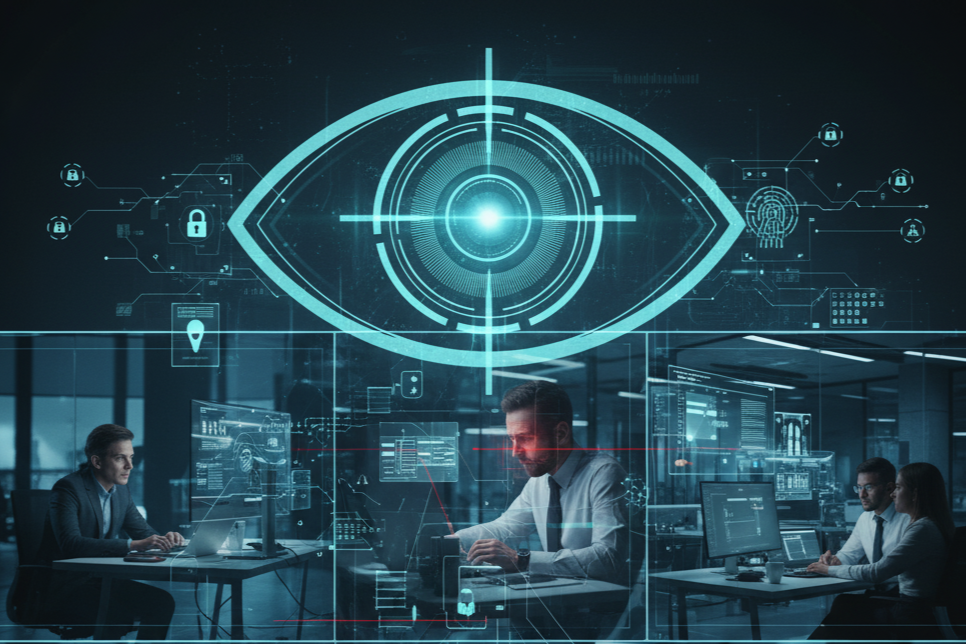The Insider Threat in the Hybrid Era: Trust No One, Verify Everyone
- SystemsCloud

- 26 minutes ago
- 3 min read
Hybrid work has given businesses the best of both worlds: flexibility, productivity, and access to talent beyond traditional offices. But it has also created new risks that many organisations are struggling to detect.
Insider threats have become harder to spot in this environment. When staff work from multiple locations, use personal devices, or connect through unsecured networks, malicious or accidental actions can slip past even the most advanced firewalls.
The shift to hybrid work requires a different mindset, one that starts from a position of zero trust. It is no longer enough to protect the perimeter; security now depends on continuous monitoring, verification, and intelligent analysis powered by AI.

What Is an Insider Threat and Why Is It Rising?
An insider threat occurs when a current or former employee, contractor, or business partner misuses their authorised access to harm the organisation. The intent may be malicious, such as data theft, or accidental, such as sharing confidential information through unsecured channels.
Hybrid work makes this problem worse for three reasons:
Reduced visibility: Staff use a mix of company and personal devices.
Remote access: Systems are opened up to allow flexible work but increase exposure.
Data sprawl: Files are now spread across cloud platforms, messaging tools, and local drives.
According to a 2025 report from IBM Security, insider incidents now account for over 30% of all data breaches, and the cost per incident continues to rise. Many are detected late, after sensitive data has already left the network.
Why Is Insider Threat Detection Harder in Hybrid Workplaces?
Traditional cybersecurity models focus on external attackers and known malware signatures. Insider threats are different because the users involved already have legitimate access.
For hybrid teams, this means:
Security logs are fragmented across cloud services.
Employees work on multiple devices from multiple locations.
Unusual behaviour blends into normal daily activity.
This lack of visibility leaves security teams guessing. Without advanced behavioural monitoring, early signs such as unusual file transfers or repeated failed logins can go unnoticed.
How Does AI Support Insider Threat Detection?
AI is increasingly vital in detecting subtle, context-based risks that humans miss. Through AI cybersecurity tools and behaviour analytics, security systems can learn what normal looks like for each user and flag deviations in real time.
How AI Behaviour Analytics Works
Monitors user activity across cloud systems, devices, and networks.
Builds a baseline profile of typical behaviour for each employee.
Detects anomalies such as odd login times, abnormal data movement, or access to restricted files.
Scores risk levels automatically for security teams to review.
AI-driven detection shortens the response window. Instead of relying on alerts after a breach, it provides context-aware early warnings that help prevent one.
What Is Zero Trust and Why Does It Matter?
The Zero Trust approach is simple: never assume any user or device is safe. Every access request is verified, regardless of location or previous authentication.
Core Principles of Zero Trust Monitoring
Continuous verification: Every session and action is checked.
Least privilege: Users access only what they need.
Micro-segmentation: Networks are divided so breaches cannot spread.
Data protection at source: Encryption and identity checks apply at every layer.
By combining AI analytics with Zero Trust monitoring, businesses gain both proactive detection and preventative control. AI spots behavioural anomalies, and Zero Trust policies limit the potential impact.
How Can Businesses Apply AI and Zero Trust Together?
Transitioning to these models does not require rebuilding the entire IT environment. The key is to integrate tools that complement each other.
Practical steps include:
Audit existing access permissions and remove unused accounts.
Implement identity-based access with multi-factor authentication.
Use AI analytics tools that provide visibility across remote endpoints.
Apply Zero Trust principles to cloud storage and collaboration systems.
Create incident response plans that factor in insider risk.
By embedding these practices, security becomes a continuous, adaptive process rather than a one-time setup.
Related reading:
Why This Approach Matters Now
The hybrid era has blurred traditional boundaries. Employees now connect from cafés, airports, and home offices. The idea of a single corporate network no longer exists.
Trust has to be earned continuously. By adopting AI-driven insider threat detection and Zero Trust monitoring, businesses can maintain visibility without compromising flexibility. This combination gives security teams confidence that their systems are being watched intelligently, even when the workforce is spread out.
The lesson for 2025 is clear: insider threats are not a technical issue alone. They are a people issue, amplified by distance and complexity. The solution lies in better visibility, constant verification, and the intelligent use of data.








Comments